Intro: Most fans knew Dick Giordano from his superhero work. But, back in the 1950s-’60s, Dick drew lots of romance comics. When I started up Last Kiss, Dick generously supplied me with valuable info about old Charlton romance comics–plus lots of moral support.
In 2001, he even drew a new story for the second issue of my Last Kiss comic book which also featured some of Dick’s old romance stories with new, twisted dialog. This interview originally appeared in that issue.
I’m posting it now because Dick passed away today and well…the world is a smaller and less friendly place without him. So here’s a few minutes with a good man that I can share with everyone. –John Lustig, March 27, 2010.
2001 interview transcribed by Christopher Irving. All art is by Dick Giordano. ©2010 Last Kiss Inc.
JOHN LUSTIG: I guess the obvious question is why—other than being a nice guy and helping me out—are you doing a Last Kiss story? I know it’s not for the money because I couldn’t pay you anywhere near your normal rate.
DICK GIORDANO: I’ve been accused of being a nice guy before and it just ain’t so! I’m as much of a lowlife as anybody else in this business. (Laughter) Certainly I didn’t do it just for the money. It really was the opportunity to do something other than superheroes. If you follow my career from the mid-‘60’s on, you’ll see that every opportunity that I had to do something other than superheroes, I took it. I hadn’t done a romance story in so long… I thought “I’ll have a little fun with this, and fit it in between deadline material.” Which is exactly what I’ve done, and I did have a little fun with it.
LUSTIG: We were playing this story for laughs, but what do you think makes a good romance story? Are there certain elements you’d look for as an artist and as an editor?
GIORDANO: From an artist’s standpoint, the difference is that you’re showing emotion rather than action. And you have an opportunity to design panels because the storytelling isn’t as critical as to what the people are doing. You can tell most romance stories with just head shots… As an editor and artist I’m looking for interesting settings and up-to-date clothing. I did that in “Muffet.” Even though you may not like it, the wedding gown and clothes that she wears are all researched.
LUSTIG: No, I liked it! (Laughter.)
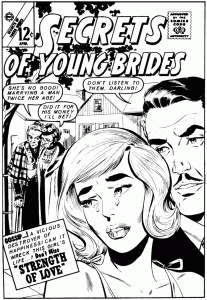
GIORDANO: That’s part of what you do for romance stories. You don’t do it for superhero stories. Most of the people who draw superheroes don’t know how to draw clothes…The differences are basically in the goal of the story. The superhero goal is for the hero to win in the end. In romances the goal is for the hero (who is usually the female lead) to get what she’s searching for.
LUSTIG: Or to painfully learn her lesson. (Laughter.) I don’t think most fans realize that most of the DC and Marvel superhero artists who became famous in the 1960’s used to draw romance comics before that. I get the feeling that some of them now view their romance work with some nostalgia. How about you?
GIORDANO: I’m not really sure that it’s nostalgia…because it’s not only romance that I miss. I started in this business in 1951, but it wasn’t until 1965 that I drew my first superhero story. In the time in between, I was drawing romance, Western, hot rod, mystery and private eye stories. All of them required a different set of skills. I cut my teeth on all of those.
Little wonder, then, that when I did start drawing superheroes, my work then (as well as now) was a little tame compared to other people who were drawing superheroes. I had all these skills I’d developed with that wide variety of genres, which is basically drawing people the way they look in settings that look realistic, with very few (if any) special effects. So I never learned those [superhero techniques] for the first 15 years of being in the business. I’ve been playing catch-up ever since. (Laughter.)
So it’s not so much nostalgia as it is using a different set of skills and approaches to telling a story.
LUSTIG: In an interview in Comic Book Artist, you indicated that when you were young you found romance comics harder to draw than action stories and that you required more visual references. That probably surprises some people.
GIORDANO: The reason they’re harder is that they’re emotionally based. The subtle hand movements and body language that you find in romance books are very hard to do from memory, so photo reference was something I used quite a bit of. Conversely, when you’re doing a superhero story, you can’t really get someone to pose photographically for some of the outrageous action that takes place. You basically have to make that all up, or follow somebody from before you who’s done it better than you’re doing it.
What I used to do with the romance stuff was take Polaroid pictures. I’d use friends as models. I would photograph half of the story and take two to three photographs for most of the covers I did.
LUSTIG: Most of the romance comics in the ‘60’s and ‘70’s were published by DC and Charlton. My impression is that DC tried to make its romance characters seem “cool and hip.” And, compared to Charlton’s characters, they were. Most of Charlton’s characters wouldn’t have been cool…even if you locked them in a Siberian deep freeze!
GIORDANO: DC really tried to make its characters more hip. It was an editorial decision to try and get relevancy into the romance comics. As you know DC did get relevance into superhero comics. The idea was that, instead of a woman walking into an office as a secretary, she would be working in something that was related to whatever was wrong with society then…like a suicide hotline where somebody would call and tell her what their problems were. In an attempt to be more relevant, DC tried to get characters that were a little more developed. Joe Orlando was editing two of DC’s comics and he was sticking pretty close to the relevancy thing…you know, gritty street heroines, that sort of thing.
However, I took a different approach. If you look at the romance books I edited (for DC), which were Young Love and (I think) Heart Throbs, you’ll see that I was basically doing what I call “fairy tales.” In essence these are the same types of stories as what’s on TV soap operas today, where everybody is beautiful and is dressed nicely and makes a huge amount of money.
LUSTIG: Gosh! I thought that was the real world! (Laughter)
GIORDANO: I have to admit that while I was at Charlton the romances were basically produced like 10 pounds of salami. The comics that weren’t in the Action Hero books or didn’t have regular characters were done in volume. Joe Gill did most, if not all, of the writing. Some of the artwork was by Nicholas and Alascia. I didn’t do that many stories myself, but a lot of the artwork was done in South America, because we had a good price break there.
If you can find any of the stories…you’ll find some work by Jose Garcia-Lopez (who was at DC), Luis Dominguez (who spent time in the American comic industry after leaving there), and a number of other people who were doing work for us through an operation called Union Studio. They had 20 to 30 artists who were available. Joe (Gill) used to write the scripts so that it would be something they’d understand.
So we pretty much stayed away from “cool” and “hip” because that doesn’t translate very well. And all of the scripts had to be translated for the artists. The artists didn’t know much about our society, so we stuck to the fairy tale stuff.
LUSTIG: I understand. When I write for Disney, I write for artists who are overseas, so I run into language and cultural differences there and I try and keep that in mind.
GIORDANO: There was also a huge difference in the amount of money that was being paid. The highest that Charlton paid, around that time, was only $20 a page, and only Steve Ditko got that. A comparable rate at DC was $45. We had to make due more often than not, and I was the only editor. I had to edit 17 books a month; we had 34 titles bi-monthly.
LUSTIG: Although a lot of comics these days have romantic subplots, there aren’t any traditional romance comics being published. Do you think it’s possible to do a straight romance comic book these days?
GIORDANO: It’s possible, of course, but I don’t know who could do it. Unfortunately, I don’t think a male audience would sit still for it. If there is a female audience, it’s mostly invisible to most of us in the business.
LUSTIG: With Last Kiss I’m finding that I have a fairly high percentage of female readers. It’s still probably mostly guys. But Last Kiss definitely has more female readers than most American comics.
GIORDANO: DC spent a considerable amount of money doing market research, in the late ‘80’s to early ‘90’s, to see if we could put out a line of romance books. Distribution is the only major problem; if we could find a way to get it to the people who would be willing to buy it and read it, maybe it would be successful.
LUSTIG: I think that with romance, you’d have to almost put it in a publication that didn’t look like a comic book, and distribute it.
GIORDANO: It depends. One of the things we found out was that there were many stay-at-home women, predominantly Hispanic, who would be interested in reading soap opera type comic books. In most of the Spanish-speaking countries, the women had romance fumetti that they grew up reading. A romance comic might be useful, if we could find a way to target such a pinpoint audience. It’s almost impossible, though.
If we were to do it today, I think it would have to be along the lines of soap opera, rather than relevant, and marketed to a more adult audience and, as you suggested, maybe done a little differently so that it wouldn’t look so much like a comic book. Maybe make it black and white and typeset. Make it magazine-sized rather than comic book size.
LUSTIG: Maybe throw in a lot of text features as well so it’d feel more like a regular book or magazine.
GIORDANO: I can’t think of any publisher that would be willing to take the chance, though.
LUSTIG: When you first started at Charlton, the company wasn’t listing credits for its artists or writers. After you became editor, Charlton starting printing credits. Why did you make that change?
GIORDANO: Most of the credits given were on the Action Hero line, although it did spill over into some of the other things. I don’t think Charlton had a policy not to list credits before that…Some artists, like Nicholas and Alascia, signed their work. So there was no policy against it, but there was also no policy insisting that they get credit. If I started giving credit, it’s because we looked around and saw that everybody else in the industry was doing that, particularly Marvel and DC.
LUSTIG: I talked to Joe Gill about whether it made any difference to him when he started getting credit. He said “no.” Did many of your contributors care about getting credit?
GIORDANO: I don’t know that Joe would have voiced it this way, but he did so much work out of necessity at Charlton, because the rates were so low. He was on-staff and doing about 100 pages a week. If you were doing a hundred pages a week, John, you probably wouldn’t want to sign all the stories.
LUSTIG: I agree. (Laughter) I like to get credit, but there are some advantages to not having your name on some things.
GIORDANO: Joe’s an amazing guy. After I left Charlton, Joe was one of the people in my studio–as well as Frank McLaughlin and Jon D’Agostino. Joe would sit behind his typewriter, look straight ahead, and start typing page one. There was no plot, and if there was it was in his head. The only time he ever plotted a story before writing it was when he did something like Peacemaker or The Fightin’ 5, and I wanted to know what the story was before he’d write it.
He’d start on page one, looking straight ahead, and he’d type very quickly, and when he was finished, he’d end on page eight. Kind of amazing. He was doing two to three eight-pagers a day.
LUSTIG: To be able to do that sort of thing everyday…for years, it’s incredible.
GIORDANO: If you read Hot Lead [a fanzine published by Last Kiss ace interview transcriber Chris Irving] you’ll find that Gill and Mickey Spillane were close friends, both writing comic books together for a long time in upstate New York. They were both doing the same things then, working for St. John’s especially. They had to bring their work in on Friday, and they’d get their check then. So the two of them would be in town and would sit down to write the stuff the day before Friday. (Laughter) They didn’t want to work the rest of the week. They’d be partying all week. On Wednesday, they’d call in with the titles so that a check could be made for them, and between then and Friday they’d finish the work. That’s a good training ground [to work quickly.]
I’m kind of fast. Anybody from my generation…is usually a little faster than the people who’ve come up recently because…the only way you could get a decent salary in the ‘50s and ‘60s was to do a lot of pages. Every company had one page rate for each of the jobs, and that didn’t change much. If you wanted to make more at $20 a page, you’d have to do more pages. You had to learn to cut through the unimportant stuff, to make only the important lines show up so you could do a few more pages.
LUSTIG: When you were the editor at Charlton you made a lot of changes. What changes are you most proud of? Do you have a favorite Charlton comic book series from that period?
GIORDANO: In order to get the Action Hero line off the ground, I had to find a way to get more money…My boss was hell-bent on us not spending more than certain amounts of money per page. So I worked out a budget with him, so that the money we saved by buying some work out of South America, I could then give to the guys like Steve Ditko and Denny O’Neil, and the other people on the Action Hero line. That was the only way I could get them the extra bucks; not a lot, but a few bucks here and a few there. I was proud of that Action Hero line. I was very disappointed in the sales, and that’s probably what led to my leaving Charlton in the first place.
Of course, my favorite Charlton comic series from that period was Sarge Steel, because I drew it! (Laughter) I’d love to do Sarge Steel again, if I could, but DC doesn’t want to do any private eyes, they want to do superheroes. Whenever I’ve brought it up, they’ve said “We’ll give him a prosthetic and it’ll have all these weapons.”
“Forget about it, that’s not what I want to do!”
I enjoyed the work on Sarge Steel, and it was the best work that I did while I was at Charlton.
LUSTIG: I’ll have to look it up, because I haven’t seen Sarge Steel.
GIORDANO: Bob Layton said, in an interview on Charlton in the ‘70’s, that he was blown away by some of the Sarge Steel work that I did, and wanted to grow up to be Dick Giordano. (Laughter) I think that is part of the reason we’re collaborating now.
NOTE: This is the end of the interview as it appeared in Last Kiss #2. However, Dick had more to say and I’m happy to make that additional material available here. In it, Dick discusses our story “Widow Ms. Muffet”; explains why he turned down the chance to be named editor-in-chief at DC Comics; reminisces about other comic book creators; and talks about the rare instances when he wrote as well as drew comics.

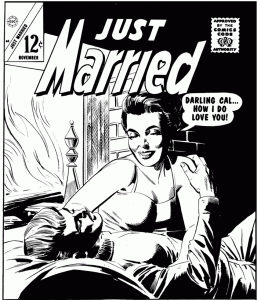
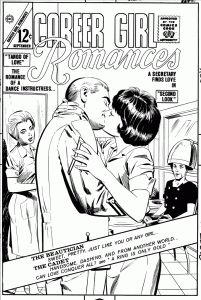
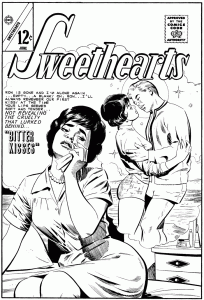
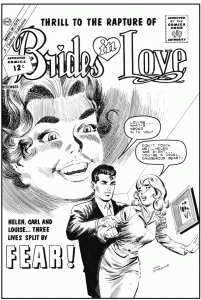
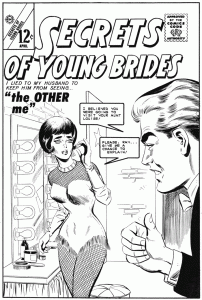

Thank You for posting this interview. You & I met at the Emerald City gig and I’ve been on your email list since. I’m really sorry I missed knowing Mr. Giordano’s work as this is the first I’ve heard of him. I’m new to the Comic Book hobby but hope I can find some of his work to begin my own collection. Thanks again, for enlightening me on another great person I missed out on….but so very glad to hear they’re still out there making a difference for someone.
I’m glad to be of help, TigerPantz. Dick played a key role at DC Comics for many years, but it’s easiest to see his talent in his art. And there’s lots of it. I don’t think he ever really retired. I don’t think he needed to work financially. He just loved comics.
Thanks for sharing…..
Great work